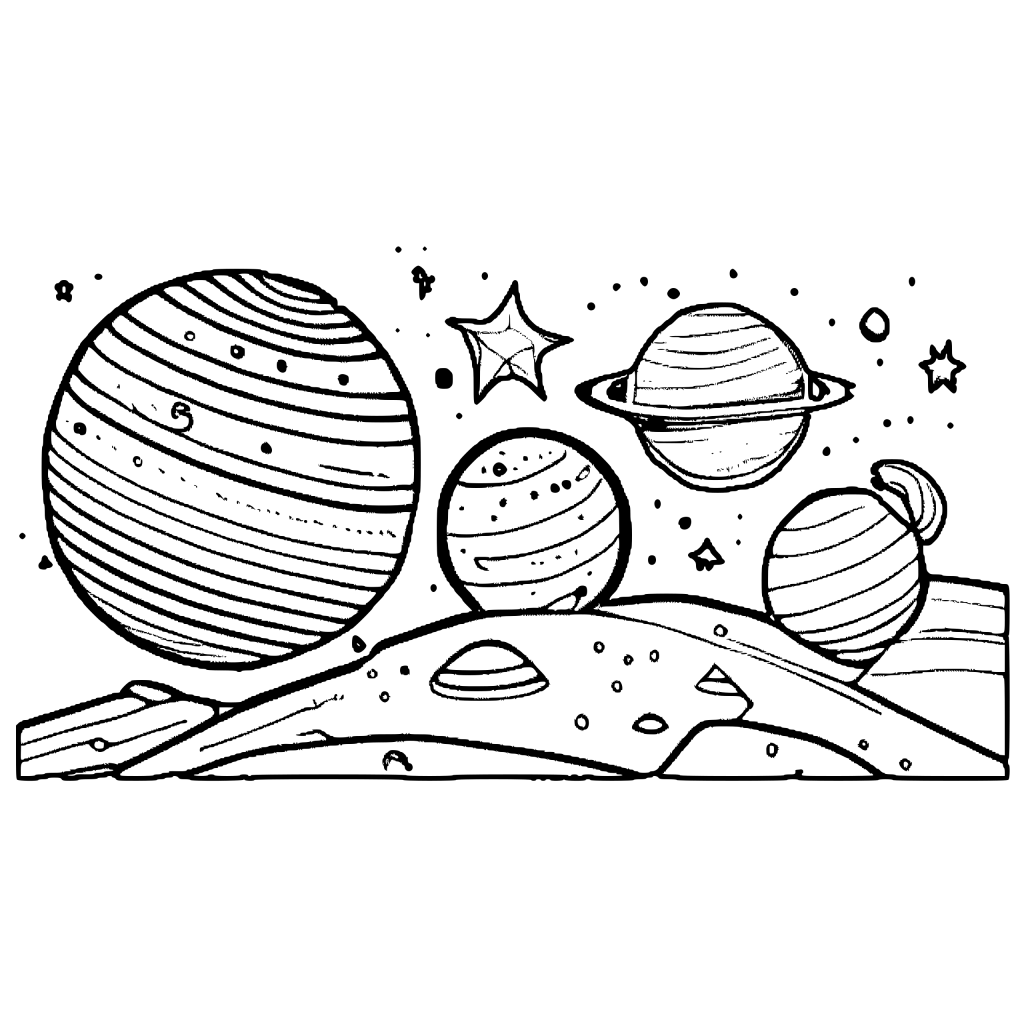An In-Depth Look at Our Celestial Neighbour
© NASA Goddard
The Moon is Earth’s most constant companion and the most accessible celestial object in the night sky. Earth’s sole natural satellite and the nearest large celestial body is known since prehistoric times, it is the brightest object in the sky after the Sun. Its diameter is about one-quarter of Earth’s making it the fifth largest satellite in the Solar System and the most enormous relative to its parent planet. It is more significant than all known dwarf planets in the Solar System.
The Moon orbits Earth at an average distance of 384,400 km (238,900 mi), or about 30 times Earth’s diameter. Its gravitational influence is the primary driver of Earth’s tides and very slowly lengthens Earth’s day. Its orbit around Earth has a sidereal period of 27.3 days. Over the course of each synodic period, spanning approximately 29.5 days, the illuminated portion of the Moon’s Earth-facing surface undergoes a transformation, ranging from none to nearly 100%. This phenomenon gives rise to the lunar phases that serve as the foundation for the months in a lunar calendar.
The Moon is gravitationally tethered to Earth, resulting in a state known as tidal locking. This means that a complete rotation of the Moon on its axis corresponds with the same side (referred to as the near side) always being oriented towards Earth. The slightly extended lunar day aligns with the duration of the synodic period. Additionally, due to periodic shifts in perspective, known as libration, approximately 59% of the lunar surface becomes observable from Earth.
Earth’s natural satellite has captivated human imagination for centuries, and its mysteries continue to unfold through the lens of scientific inquiry. This lunar realm, with its stark beauty and unique characteristics, presents a wealth of scientific phenomena to study and understand. From its formation to its geological features, from its influence on Earth’s tides to its potential as a stepping stone for future space exploration, the Moon offers a fascinating journey into the realms of astronomy, geology, and space science.
FORMATION
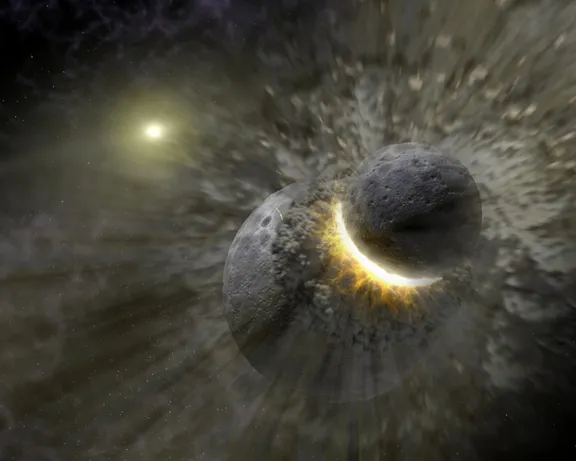
The formation of Earth‘s Moon is a story written in the cosmic history of our solar system, a tale of celestial collisions and gravitational dances that took place over 4.5 billion years ago. This pivotal event not only shaped the Moon itself but profoundly influenced the course of our planet’s evolution.
A COSMIC COLLISION
The leading theory regarding its formation is the Giant Impact Hypothesis. According to this hypothesis, shortly after Earth‘s formation, a Mars-sized object, often referred to as “Theia,” collided with our young planet in a cataclysmic event. The impact was so colossal that it blasted molten debris into space, which eventually coalesced to form our Moon. This dramatic birth gave the Moon its distinctive composition and orbital characteristics.
CLUES FROM LUNAR ROCKS
Key insights into lunar formation come from the lunar rocks and soil samples brought back by the Apollo missions. These samples provided valuable clues about the Moon’s composition and allowed scientists to confirm that the Moon is made of material similar to Earth‘s mantle. The presence of certain isotopes also supports the Giant Impact Hypothesis, as they indicate that the Moon’s material indeed came from a different source than Earth‘s.
ORBITAL DYNAMICS
The Moon’s unique orbital dynamics further support the Giant Impact Hypothesis. Unlike most moons in the solar system, our Moon is relatively large compared to Earth and orbits at a considerable distance. It’s thought that the energy transferred during the collision with Theia played a pivotal role in shaping the Moon’s size and orbit, as well as its synchronous rotation, which results in the same face always pointing toward Earth.
ONGOING RESEARCH
While the Giant Impact Hypothesis is the prevailing theory, ongoing research continues to refine our understanding of lunar formation. Computational simulations and further analysis of lunar samples aim to fill in the gaps in our knowledge and answer remaining questions about the exact nature of the impact and the subsequent processes that formed the Moon.
The Moon’s origin story serves as a reminder of the interconnectedness of celestial bodies in our solar system and their profound impact on the evolution of our home planet. As we peer into the distant past to uncover the secrets of lunar formation, we gain not only a deeper understanding of the Moon itself but also a clearer view of the intricate dance of celestial bodies that shaped the world we know today.
STRUCTURE

The Moon exhibits a structure akin to Earth, consisting of various discernible layers and zones. However, it is notably smaller and less intricate compared to our planet. Within the Moon lies a compact, iron-rich inner core, potentially with a radius as diminutive as 240 kilometers (150 mi). Surrounding this core is a fluid outer layer primarily composed of liquid iron, extending to approximately 300 kilometers (190 mi) in radius. Around the core is a partially molten boundary layer with a radius of about 500 kilometers (310 mi). This structure is thought to have developed through the fractional crystallization of a global magma ocean shortly after the Moon’s formation 4.5 billion years ago.
CRUST
The Moon’s outermost layer is its crust. It is composed primarily of various types of rock, including basalt and anorthosite. The lunar crust is considerably thinner than Earth‘s and varies in thickness across the Moon’s surface, with thicker regions found in the highlands and thinner areas in the lunar maria, which are large, flat plains.
MANTLE
Beneath the crust lies the lunar mantle. The mantle is composed of solid rock and extends to a depth of about 1,000 kilometers (about 620 miles) beneath the lunar surface. It is responsible for the Moon’s geological activity, including volcanic eruptions that formed the lunar mare.
LUNAR CORE
While Earth has a liquid outer core and a solid inner core, the Moon is believed to have a small, partially molten core. The size and composition of the lunar core are subjects of ongoing research and debate. Some studies suggest it may be partially molten and contain a mixture of iron and sulfur.
MANTLE TRANSITION ZONE
Between the mantle and the core, there may be a transitional layer or zone with variations in temperature and composition. Research into the exact nature of this region is ongoing.
CHARACTERISTICS
| MASS | 7.342×1022 kg |
| VOLUME | 2.1958×1010 km3 |
| SURFACE AREA | 3.793×107 km2 |
| MEAN RADIUS | 1737.4 km |
| SURFACE PRESSURE | 10−7 Pa |
| DENSITY | 3.344 g/cm3 |
| ESCAPE VELOCITY | 2.38 km/s |
| SURFACE GRAVITY | 1.622 m/s2 |
| ABSOLUTE MAGNITUDE | 0.2 |
| NATURAL SATELLITES | 0 |
| RINGS | NO |
| MEAN TEMPERATURE | -23.15 °C |
| SEMI-MAJOR AXIS | 384399 km |
| ORBIT PERIOD | 27.321661 days |
| MEAN ORBITAL VELOCITY (orbit about Earth) | 1.022 km/s |
| MAXIMUM ORBITAL VELOCITY (orbit about Earth) | 1.082 km/s |
| MINIMUM ORBITAL VELOCITY (orbit about Earth) | 0.970 km/s |
| ORBIT INCLINATION | 5.145° |
| ORBIT ECCENTRICITY | 0.0549 |
| SIDEREAL ROTATION PERIOD | 655.720 hours |
| LENGTH OF DAY | 24 hours |
GRAVITATIONAL FIELD
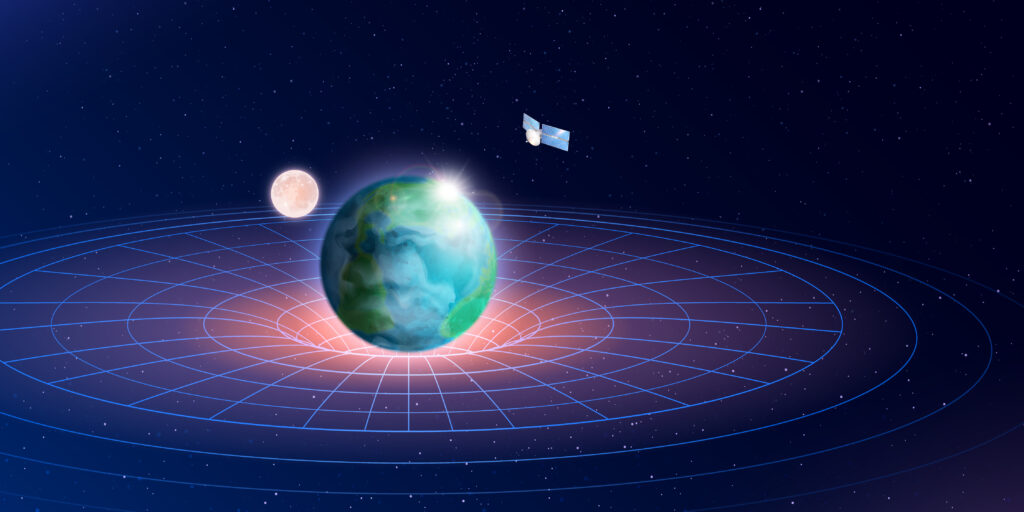
The gravitational field of the Moon, like any other celestial body, is a complex phenomenon governed by the principles of gravitational physics. Here, I will provide a detailed explanation of the gravitational field of the Moon.
GRAVITATIONAL CONSTANT (G)
The Moon’s gravitational field is governed by the gravitational constant (G), a fundamental physical constant with an approximate value of 6.674 × 10-11 m3 kg-1 s-2. This constant establishes the magnitude of the gravitational attraction between two objects possessing mass.
MASS
The Moon has a mass of approximately 7.35 x 1022 kilograms. This mass is distributed unevenly throughout the Moon’s interior, with denser regions near the core and lighter regions towards the surface.
ACCELERATION DUE TO GRAVITY
The Moon’s gravitational field creates an acceleration due to gravity on its surface. This acceleration is approximately 1.625 m/s2, which is about 1/6th the strength of Earth‘s gravitational acceleration (9.81 m/s2). This is why astronauts on the Moon’s surface experience lower weight and can jump higher compared to Earth.
GRAVITATIONAL POTENTIAL
The gravitational potential, also known as gravitational potential energy per unit mass, decreases as you move away from its surface. It is highest at the Moon’s surface and approaches zero as you move infinitely far away from the Moon.
ORBITING OBJECTS
The Moon’s gravitational field influences the motion of objects in its vicinity. Objects in orbit around the Moon experience a centripetal force that keeps them in their orbits. The strength of this force depends on the mass of the object, its distance from the Moon, and the Moon’s gravitational constant.
TIDES
The gravitational influence of the Moon gives rise to tides on Earth. It induces a deformation of water, forming a raised area on the side of the Earth directly facing the Moon, as well as a corresponding bulge on the opposite side, stemming from the disparity in gravitational force across the planet. This phenomenon is responsible for the occurrence of ocean tides.
VARIATIONS IN GRAVITATIONAL FIELD
The Moon’s gravitational field is not perfectly uniform. It varies slightly across its surface due to variations in the Moon’s mass distribution. This has been mapped and studied by lunar missions, such as the Lunar Reconnaissance Orbiter, which provide detailed information about the Moon’s gravitational anomalies.
MAGNETIC FIELD
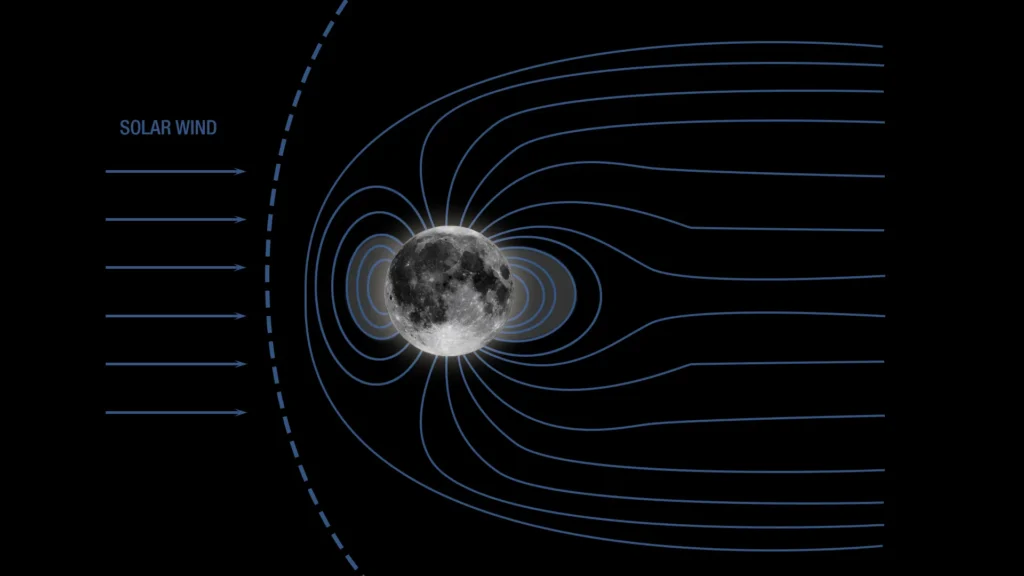
The Moon, unlike the Earth, does not have a global magnetic field generated by a liquid iron-nickel core like our planet. However, it does exhibit localized magnetic anomalies, and its magnetic field is more complex than originally thought.
ABSENCE OF A GLOBAL MAGNETIC FIELD
The Moon lacks a global magnetic field similar to Earth‘s because it doesn’t have a large, molten iron-nickel core. Earth‘s magnetic field is primarily generated by the motion of molten iron in its outer core, a process known as the geodynamo. The Moon’s smaller size and cooling history led to the solidification of its core early in its history, preventing the generation of a global magnetic field.
MAGNETIC ANOMALIES
Instead of a global magnetic field, the Moon has localized magnetic anomalies. These are areas where the lunar crust contains pockets of magnetic minerals. These magnetic anomalies can be remnants from the Moon’s volcanic past when some areas were magnetized by the presence of a magnetic field during volcanic activity.
MAGNETIC INTENSITY
The strength of the Moon’s magnetic field is quite weak compared to Earth‘s. The lunar magnetic field’s intensity is typically on the order of tens to hundreds of nanoteslas (nT), while Earth‘s magnetic field is measured in microteslas (μT).
MAPPING THE MAGNETIC FIELD
The magnetic field of the Moon has been mapped extensively by spacecraft, including the Lunar Prospector and the Lunar Reconnaissance Orbiter (LRO). These missions have provided valuable data on the distribution and intensity of lunar magnetic anomalies.
ORIGIN OF LUNAR MAGNETISM
There are several theories about the origin of lunar magnetism, but it is not fully understood. One hypothesis is that meteoroid impacts during the Moon’s early history could have created magnetic anomalies by generating shock-induced magnetization in the rocks. Another possibility is that some lunar basalts contain magnetic minerals like iron-titanium oxides, which could contribute to local magnetic fields.
VARIATIONS IN MAGNETIC FIELD
The strength and distribution of lunar magnetic anomalies vary across the Moon’s surface. Some regions have stronger magnetic fields than others, indicating variations in the composition of lunar rocks.
IMPLICATIONS FOR LUNAR EXPLORATION
Understanding the Moon’s magnetic anomalies is important for lunar exploration. They can affect spacecraft trajectories and navigation when close to the Moon’s surface. Additionally, studying lunar magnetic anomalies can provide insights into the Moon’s geological history, including its volcanic activity and impact history.
In summary, the Moon does not have a global magnetic field like Earth, but it does possess localized magnetic anomalies resulting from the presence of magnetic minerals in its crust.
ATMOSPHERE
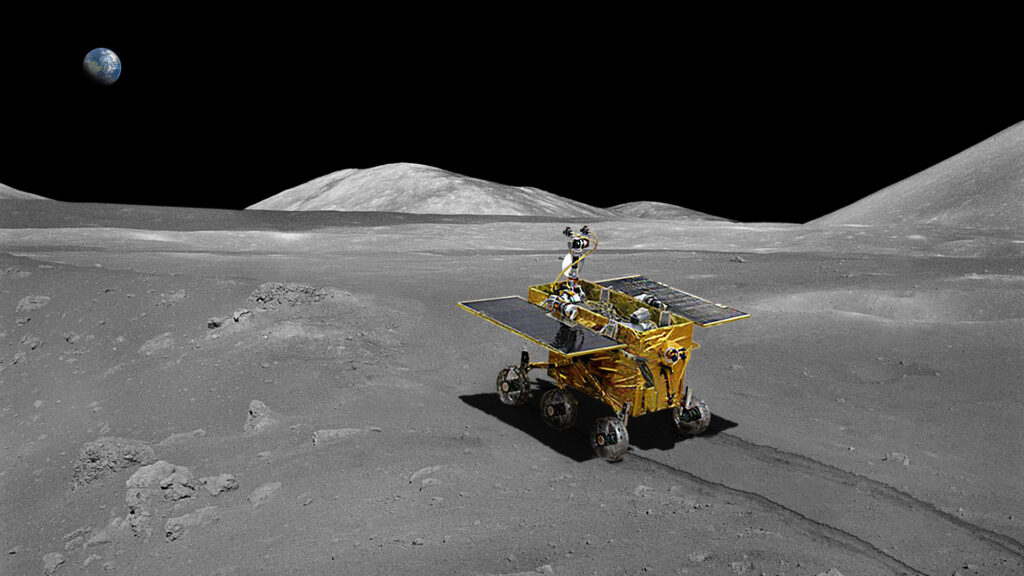
The Moon’s atmosphere, often referred to as an exosphere, is vastly different from Earth‘s atmosphere. It is extremely tenuous, almost to the point of being a vacuum, and consists of a very low-density collection of particles.
COMPOSITION
The lunar exosphere primarily consists of three main components:
EXOSPHERIC GAS
This includes trace amounts of various gases such as helium, neon, hydrogen, and argon. These gases are present in extremely low concentrations, with the total atmospheric pressure equivalent to only about 3 x 10-15 bars.
DUST AND PARTICLES
The exosphere also contains fine dust particles known as lunar regolith. These particles can be kicked up by micrometeoroid impacts or by solar radiation and can temporarily hover above the surface before falling back.
IONS
The Moon’s exosphere contains a very small number of ions, generated by the interaction of solar wind particles with the lunar surface. These ions are primarily composed of hydrogen and helium.
LACK OF SIGNIFICANT ATMOSPHERE
Unlike Earth, the Moon does not have a significant atmosphere that can support human life or create atmospheric pressure. The lack of a substantial atmosphere contributes to extreme temperature variations on the lunar surface, as there is no atmosphere to trap heat.
ESCAPE OF GASES
Because of the Moon’s weak gravitational field, it cannot hold onto gases like Earth does. Gases that enter the lunar exosphere are prone to escape into space due to the Moon’s low gravitational pull. This is one of the reasons why the lunar atmosphere is so sparse.
DAY-NIGHT TEMPERATURE EXTREMES
Without a substantial atmosphere to distribute heat, the Moon experiences extreme temperature variations. During the lunar day (which lasts about 14 Earth days), temperatures can reach up to 127 degrees Celsius (260 degrees Fahrenheit). Conversely, during the lunar night, temperatures can drop to around -173 degrees Celsius (-280 degrees Fahrenheit).
SOLAR WIND INTERACTION
The Moon’s exosphere is continually influenced by the solar wind, a stream of charged particles emitted by the Sun. Solar wind particles collide with the lunar surface and can cause the release of atoms and ions from the surface materials, contributing to the exosphere’s composition.
SURFACE-BOUND ATMOSPHERE
While the Moon’s exosphere is exceedingly thin, it can be considered “surface-bound” in the sense that it interacts with the lunar surface and is affected by surface processes such as outgassing from lunar rocks.
In summary, the Moon’s atmosphere, or exosphere, is an extremely tenuous and sparse collection of gases, dust particles, and ions. It lacks the protective and stabilizing qualities of Earth‘s atmosphere, leading to extreme temperature fluctuations and an inability to support human life without specialized equipment.
ROTATION

The Moon’s rotation is a fascinating topic, and it has some unique characteristics compared to the rotation of other celestial bodies like Earth.
SYNCHRONOUS ROTATION
The Moon is in synchronous rotation with Earth, which means it rotates on its axis in such a way that it always shows the same face, or “near side,” to Earth. This synchronous rotation is the result of a tidal locking process, and it’s why we only see one side of the Moon from Earth.
ORBITAL PERIOD
The Moon takes approximately 27.3 days to complete one orbit around Earth. This period is known as the sidereal month, and it’s the time it takes for the Moon to return to the same position in relation to distant stars. However, it’s important to note that it takes about 29.5 days to complete one orbit in relation to the Sun, which is known as the synodic month. This difference is due to the motion of Earth in its orbit around the Sun.
ROTATION PERIOD
The Moon’s rotation period, or the time it takes to complete one full rotation on its axis, is also approximately 27.3 days. This rotation period is synchronized with its orbital period, resulting in the same side of the Moon always facing Earth.
TIDAL LOCKING
The process of tidal locking is the result of gravitational interactions between the Moon and Earth. Over billions of years, Earth‘s gravitational forces acted on the Moon’s tidal bulge, causing the Moon’s rotation to gradually slow down until it became tidally locked. This process also caused a transfer of angular momentum, resulting in the Moon’s synchronous rotation.
FAR SIDE OF THE MOON
The side of the Moon opposite the Earth is known as the “far side” or “dark side” of the Moon. It is not permanently dark; it experiences day and night like the near side. However, because it faces away from Earth, it remained largely unexplored and hidden from view until the space age. The first images of the far side were captured by the Soviet Luna 3 spacecraft in 1959.
LIBERATION
Although the Moon is in synchronous rotation, it exhibits a small oscillatory motion known as “libration.” Libration is caused by variations in the Moon’s orbital speed and the tilt of its axis. These factors allow us to see a little beyond the lunar limb and observe about 59% of the Moon’s surface over time.
IMPACT ON LUNAR FEATURES
The Moon’s synchronous rotation has significant implications for its surface features. The near side of the Moon has more maria (large, dark plains) and fewer highlands compared to the far side. The far side is dominated by highlands and has a more rugged terrain.
VIEW FROM EARTH
Because of the Moon’s synchronous rotation, we always see the same features on the lunar surface from Earth. This predictable visibility has made the Moon a valuable object for scientific observation and lunar exploration. In conclusion, the Moon is Earth‘s natural satellite, approximately 1/6th the size of our planet. It has a complex history and composition, featuring two main types of terrain – the rugged highlands and the smooth maria.
The Moon has a synchronous rotation, always showing the same face as Earth due to tidal locking. Its lack of a substantial atmosphere leads to extreme temperature variations. The Moon has played a crucial role in human history, from cultural significance to space exploration, and continues to be a subject of scientific study and potential future lunar missions.
Learn about Earth and Moon System here.
